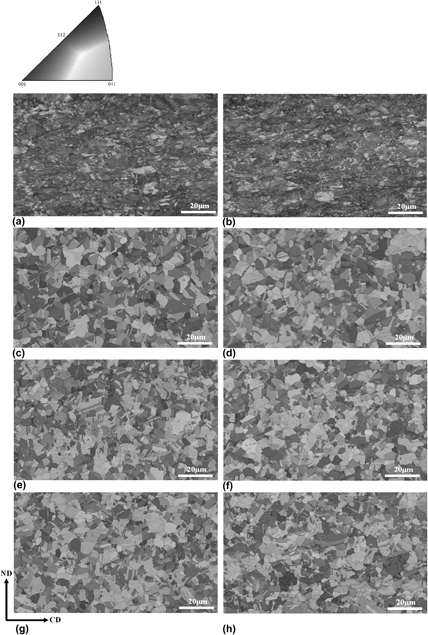Crossref Citations
This article has been cited by the following publications. This list is generated based on data provided by
Crossref.
Wang, Xinli
Dai, Wenbin
Ma, Chongwei
and
Zhao, Xiang
2014.
Effect of electric current direction on recrystallization rate and texture of a Cu–Zn alloy– CORRIGENDUM.
Journal of Materials Research,
Vol. 29,
Issue. 2,
p.
294.
Wang, Xinli
Dai, Wenbin
Wang, Rui
Tian, Xinzhong
Zhao, Xiang
and
Li, Jianming
2014.
A Method to Distinguish Twinning Variants and Second Twins by EBSD Measurements.
Acta Metallurgica Sinica (English Letters),
Vol. 27,
Issue. 2,
p.
267.
Zhao, Xiang
Wang, Xin Li
Li, Dong Xue
and
Dai, Wen Bin
2014.
Orientation Correlation during α→β Up-Transformation Induced by Electric Current Pulses in a Cu-Zn Alloy.
Materials Science Forum,
Vol. 783-786,
Issue. ,
p.
2406.
Kuang, Jie
Li, Xiaohui
Ye, Xiaoxin
Tang, Jianguo
Liu, Haifeng
Wang, Jeff
and
Tang, Guoyi
2015.
Microstructure and Texture Evolution of Magnesium Alloys During Electropulse Treatment.
Metallurgical and Materials Transactions A,
Vol. 46,
Issue. 4,
p.
1789.
Guo, J. D.
Wang, X. L.
and
Dai, W. B.
2015.
Microstructure evolution in metals induced by high density electric current pulses.
Materials Science and Technology,
Vol. 31,
Issue. 13,
p.
1545.
Wang, Xinli
Liu, Meishuai
Dai, Wenbin
Wu, Nan
and
Zhao, Xiang
2015.
Effect of electric current direction on the microstructural evolution and mechanical properties of a cold-rolled Cu–Zn alloy during the phase transformation induced by electric current pulses.
Journal of Materials Research,
Vol. 30,
Issue. 16,
p.
2500.
Liu, Kai
Dong, Xianghuai
Xie, Huanyang
and
Peng, Fang
2015.
Effect of pulsed current on the deformation behavior of AZ31B magnesium alloy.
Materials Science and Engineering: A,
Vol. 623,
Issue. ,
p.
97.
Zhao, X.
Wang, X. L.
Dai, W. B.
Liu, M. S.
and
Wu, N.
2015.
Engineering Solutions for Sustainability.
p.
103.
Zhao, X.
Wang, X. L.
Dai, W. B.
Liu, M. S.
and
Wu, N.
2015.
Engineering Solutions for Sustainability.
p.
103.
Kuang, Jie
Low, Thaddeus Song En
Niezgoda, Stephen R.
Li, Xiaohui
Geng, Yubo
Luo, Alan A.
and
Tang, Guoyi
2016.
Abnormal texture development in magnesium alloy Mg–3Al–1Zn during large strain electroplastic rolling: Effect of pulsed electric current.
International Journal of Plasticity,
Vol. 87,
Issue. ,
p.
86.
Kuang, Jie
Li, Xiaohui
Zhang, Ruikun
Ye, Yongda
Luo, Alan A.
and
Tang, Guoyi
2016.
Enhanced rollability of Mg 3Al 1Zn alloy by pulsed electric current: a comparative study.
Materials & Design,
Vol. 100,
Issue. ,
p.
204.
Kuang, Jie
Du, Xinpeng
Li, Xiaohui
Yang, Yanyang
Luo, Alan A.
and
Tang, Guoyi
2016.
Athermal influence of pulsed electric current on the twinning behavior of Mg–3Al–1Zn alloy during rolling.
Scripta Materialia,
Vol. 114,
Issue. ,
p.
151.
Li, Xiaopei
Li, Xiaohui
Kure-Chu, Song-Zhu
and
Tang, Guoyi
2018.
A Comparative Study on the Static Recrystallization Behavior of Cold-Rolled Mg-3Al-1Zn Alloy Stimulated by Electropulse Treatment and Conventional Heat Treatment.
Metallurgical and Materials Transactions A,
Vol. 49,
Issue. 2,
p.
613.
Zhao, Shuchun
Zhu, Qi
An, Xianghai
Wei, Hua
Song, Kexing
Mao, Scott X.
and
Wang, Jiangwei
2020.
In situ atomistic observation of the deformation mechanism of Au nanowires with twin–twin intersection.
Journal of Materials Science & Technology,
Vol. 53,
Issue. ,
p.
118.
Kuang, Jie
Du, Xinpeng
Al-Samman, Talal
Li, Xiaohui
Liu, Gang
and
Sun, Jun
2020.
On the Texture Weakening During Electropulse Annealing Treatment of Mg-1Ce Alloy: The Role of Nucleation and Nucleus Growth.
Metallurgical and Materials Transactions A,
Vol. 51,
Issue. 12,
p.
6640.
Guo, Haojie
Liu, Pu
Qin, Xunpeng
Song, Yanli
Qian, Dongsheng
Xie, Lechun
Wang, Liqiang
Zhang, Lai-Chang
and
Hua, Lin
2021.
Electroshock treatment dependent microstructural evolution and mechanical properties of near-β titanium alloy manufactured by directed energy deposition.
Materials & Design,
Vol. 212,
Issue. ,
p.
110286.
Huang, Tao
Yang, Fan
Xing, Bing-Hui
Song, Ke-Xing
Xiang, Nan
Zhang, Yan-Min
Chen, Xue-Wen
and
Guo, Jun-Qing
2024.
Effects of electrical pulse on metal deformation behaviors.
Materials Research Express,
Vol. 11,
Issue. 3,
p.
032003.



